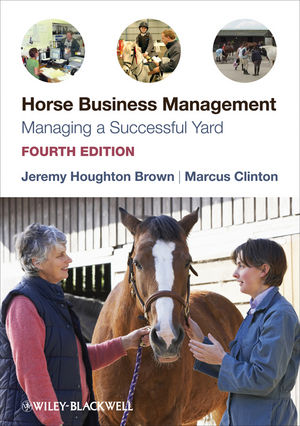Horse Business Management: Managing a Successful Yard, 4th EditionISBN: 978-1-4051-8347-5
Paperback
288 pages
May 2010, Wiley-Blackwell
 |
||||||
Preface x
Dedication xi
Section 1: Setting the Right Course 1
1 A Successful Horse Business 3
Introduction – The Ingredients of Success 3
Defining Success 3
Safety and Legality 5
Equine Standards 5
Vision and Leadership 5
Entrepreneurial Flair 6
Human Resources 6
Marketing 7
Common Characteristics and Trends of Horse Businesses 7
The Business Environment 9
Challenges of a Horse Business 10
2 The Customer in the Market Place 11
Introduction 11
What do We mean by Market? 11
Stakeholders in the Business 12
Customer Care 18
3 Quality 22
Introduction to Quality 22
So what is Quality? 23
The Management of Quality 24
End of Section 1 – Setting the Right Course 30
Section 2: Staying On Course 31
4 Health and Safety 33
Introduction 33
Accidents and Blame 34
Developing a Health and Safety Culture 35
Health and Safety Management 39
5 Legality and Insurance 49
Introduction 49
The Law of Contract 50
Express Warranties and Conditions 53
Misrepresentation 53
Contracts of Employment 54
The Law of Tort 56
Insurance 66
6 Finance and Profit 70
Introduction 70
Raising Money 70
Taxation 72
Performance Management 75
Financial Risk Management 83
7 Marketing and Mission 84
Introduction 84
Market Research 84
Mission Statement 87
Marketing Strategies 88
8 Context and Content 100
Introduction 100
The British Horse Industry 100
Training, Education and Careers 106
End of Section 2 – Staying on Course 108
Section 3: Delivering Results 109
9 Yard and Enterprise Management 111
Introduction 111
Premises Considerations 111
Routines 128
Daily Duties 131
Labour-saving Devices 134
Enterprises 135
Grassland Management 149
10 Staff and Office Management 155
Introduction 155
Recruitment 155
Job and Person Specifi cations 156
Interviewing 157
Employment and Employing Staff 159
Motivation 160
Communication 162
Management Style 163
Remuneration and Benefits 164
Staff Training 165
Organisation 170
Office Routines 171
Equipment 172
Records 175
11 Managing Shows and Events 178
Introduction 178
The Nature of Shows and Events 179
The Principles of Running a Good Show 182
Looking Back 194
12 The Eye of the Master 202
Looking Back 202
Looking Around 202
Looking Forward 203
Looking Diligently 204
End of Section 3 – Delivering Results 205
Appendices 207
Appendix 1 Facts, Figures and Organisations 209
Overview of Organisations within the British Horse Industry 209
Useful Facts about the British Horse Industry 222
Useful Figures about the British Horse Industry 226
Appendix 2 Guidance on Promoting Safe Working Conditions 229
General Advice for all Horse Establishments 229
Additional Specific Guidance for Horse Riding Establishments 239
Additional Specific Guidance for Studs and Horse Breeding Establishments 243
Additional Specific Guidance for Racehorse Training Establishments 245
Control of Substances Hazardous to Health Regulations 246
Risk Assessment 247
Appendix 3 Career Training for Work in the Horse Industry 250
Introduction 250
Career Preparation 251
College qualifications 252
NVQs, Traineeships and Apprenticeships 252
BHS Professional Qualifications 253
Association of British Riding Schools (ABRS) and
National Pony Society (NPS) 253
United Kingdom Coaching Certificate (UKCC) 254
Other Professional and Technical Qualifications 256
Portfolios and CVs 256
Appendix 4 National Vocational Qualifications (Including Teaching Level 3 Management and Supervisory Skills) 257
Introduction to Vocational Qualifications (S/NVQs) 257
NVQ Level 1 258
NVQ Level 2 258
NVQ Level 3 259
NVQ Level 4 260
NVQ Structure within each Level 260
NVQ Methods of Assessment 261
NVQ Level 3 – Management and Supervisory Units 261
Index 271



